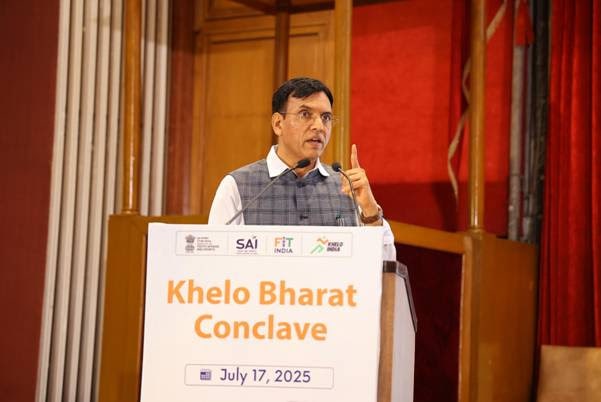

The Union Minister for Youth Affairs and Sports, Dr. Mansukh Mandaviya, on Thursday, outlined
India’s strategy towards finishing among the top 10 nations in the 2036 Summer Olympics and Paralympics has been outlined.
This became clear in a well-attended Khelo Bharat Conclave where key stakeholders from the Indian Olympic Association, Paralympic Committee of India, National Sports Federations, leading sports institutions, prominent corporate houses, and senior figures from the Indian sports ecosystem came together.
They were there for a day-long brainstorming session focused on charting the roadmap to position India as a global sporting powerhouse by 2047.

The interactive Khelo Bharat Conclave covered several key pillars enshrined in the Khelo Bharat Niti 2025 (sports policy). Among them, critical discussions were held on the importance of good governance and the upcoming National Sports Governance Bill that will be tabled in the Monsoon session of Parliament starting July 21.
While athletes remain at the heart of the Khelo Bharat Niti, the government has highlighted how the National Sports Federations, State governments and corporate houses have to play a major role to ensure India finishes among the top 10 nations in 2036 Summer Olympics and the Paralympics.

The Union Minister for Youth Affairs and Sports, Dr. Mansukh Mandaviya who addressed the conclave,said:
“Sports is a public movement. We can set goals and achieve them only if we all work together. Our Prime Minister Narendra Modi ji always believes in a united force when it comes to sport and we have to shed our egos, focus on comprehensive planning and convert plans into a substantial output.”
Stakeholders attending the six-hour-long Khelo Bharat conclave were unanimous in their view that the government policy was ambitious and an honest endeavour towards achieving global standards in sports.
The Conclave featured four impactful presentations, i.e. on Sports Governance reforms, the Khelo Bharat Niti 2025, India’s medal-winning roadmap, and the ‘One Corporate One Sport’ initiative, collectively outlining a comprehensive vision to transform India into a global sporting powerhouse. Every presentation was followed by interactive sessions where several stakeholders offered suggestions that were recorded by senior ministry officials.

Union Minister of State for Youth Affairs and Sports, Smt. Raksha Nikhil Khadse, said the Khelo Bharat Niti was drafted after studying the “ground realities” and “challenges” facing Indian sports. It has taken the government more than a year to frame the document that saw several updates after protracted discussions with key stakeholders. “Now we have an opportunity to ride sports and by employing this integrated policy, India can shine in the world of entertainment, provide jobs and really provide direction to the youth of India,” said Smt Khadse.

While the need for good governance was emphasised, there were hectic discussions on producing quality coaches, groom quality sports administrators, develop sports goods business and control the menace of doping.The ministry has urged NSFs for a proper calendar of events so that athletes do not suffer logistical issues.
The Ministry appears to be focusing on a three-layered structure integrated talent development pyramid starting with schools and converging at the proposed Olympic Training Centres.
The government has already outlined a 10-year plan (with a well laid out strategy for 2026-27 to 2030-31 and then building over the momentum) starting with residential sports school from where talented children will have the opportunity to reach the intermediate level and then finally graduate to the elite division that will cater to potential international medal winners.

Dr. Mandaviya has emphasised the role of States in nation building. Given the enormity of the task at hand to convert India’s dream to be in the top echelons of global sports, the government has mooted the idea to sign agreements with states, schools, and corporates as and when required to obtain long-lasting results.